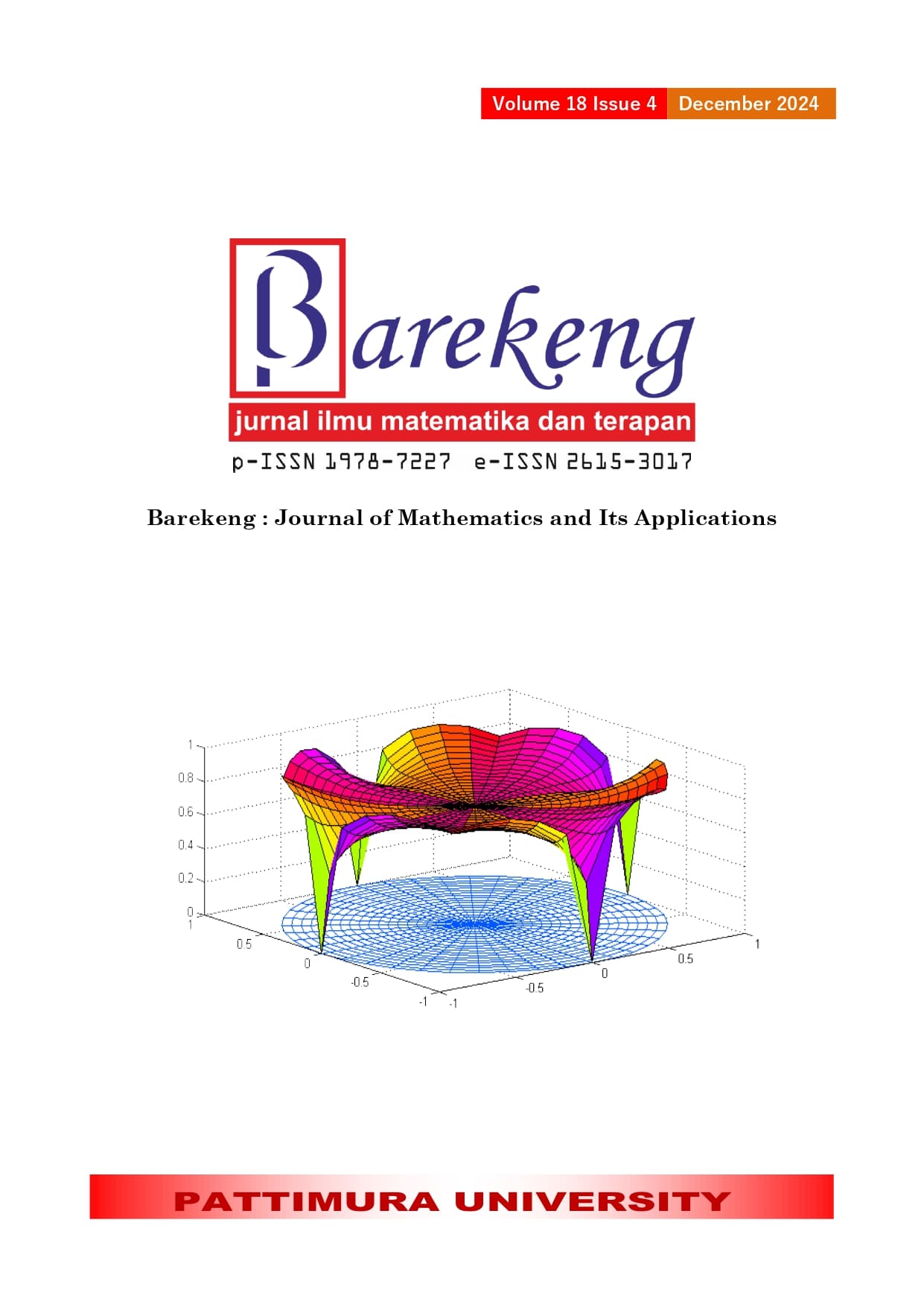APPLICATION OF YATES METHOD FOR MISSING DATA ESTIMATION IN YOUDEN SQUARE DESIGN AND ANALYSIS
Abstract
The Youden square design is widely used in experimental research to control two sources of variability, but missing data can compromise the results. Addressing missing data is critical to maintaining the integrity and reliability of such experiments. This paper proposes to adapt the Yates method to handle missing data specifically in Youden square designs. We begin by outlining the structure of the Youden square design and the challenges posed by missing data. The Yates method, known for its robustness in estimating missing data, is adapted to fit this design. We demonstrate its effectiveness through simulations and real-world case studies. The simulation involved generating experimental data with one missing value, and the case study analyzed chemical process research with critical missing data points. The results show that the Yates method maintains statistical validity and improves data completeness compared to traditional methods. Its advantage lies in utilizing Youden's quadratic structure for more accurate estimation. This study highlights the Yates method as a solution to handle missing data, improving the quality and reliability of experimental research.
Downloads
References
A. Dean, D. Voss, and D. Draguljic, "Design and Analysis of Experiments 2nd ed," New York, NY: Springer New York, 2017, doi: 10.1007/978-3-319-52250-0.
I. Munawwaroh, L. Saliaputri, S. M. Herdiyani, T. T. Puspasari, and S. Winarni, “Implementasi Analisis Variansi Pada Desain Bujur Sangkar Youden Untuk Eksperimen,” Equator J. Math. Stat. Sci., vol. 2, no. 1, p. 10, 2023, doi: 10.26418/ejmss.v2i1.64598.
E. Karageorgou and V. Samaniduo, "Youden Test Application in Robustness Assays During Method Validation," Journal of Chromatography A., vol. 1353, pp. 131-139, 2014, doi: 10.1016/j.chroma.2014.01.050.
A. R. J. Degray, “American Society for Quality The Sequential Youden Square American Society for Quality Stable URL : http://www.jstor.org/stable/1267359,” vol. 12, no. 1, pp. 147–152, 2016.
Y. Hua, A. S. Hedayat, M. Yang, and S. Altan, “An Extended Youden Design in Biological Assays,” Stat. Biopharm. Res., vol. 13, no. 3, pp. 330–336, 2021, doi: 10.1080/19466315.2020.1841023.
T. Taner and J. Antony, “The assessment of quality in medical diagnostic tests: A comparison of ROC/Youden and Taguchi methods,” Int. J. Health Care Qual. Assur., vol. 13, no. 7, pp. 300–307, 2000, doi: 10.1108/09526860010378744.
E. W. Yunitasari, "Desain dan Analisis Eksperimen Menggunakan Bujursangkar Youden di PT. XYZ," vol. 2, no.2, 2019.
H. M. Uti, S. Alisya, M. A. Rahmah, "Analisis Perakitan Komponen Televisi dengan Rancangan Bujur Sangkar Youden," BIAStatistics Journal of Statistics Theory and Aplication¸vol. 17, no. 2, pp. 47-53, 2023.
D. C. Montgomery, Design and analysis of experiments. John Wiley & Sons, Inc., 2017.
T. Yaumira, C. Firmansyah, and R. M. Hadiputri, “Desain Youden Sebagai Desain Bujur Sangkar Latin Tak Lengkap,” vol. 6274, pp. 1–13, 2023.
A. K. Kaushik and P. Kaushik, “Analysis of Youden square design with several missing observations,” vol. 4, no. 5, pp. 104–111, 2019.
A. S. Dewi, T. Widiharih, and R. Rahmawati, “Analisis Variansi Pada Rancangan Bujur Sangkar Youden Dengan Dua Data Hilang,” J. Gaussian, vol. 8, no. 3, pp. 356–365, 2019, doi: 10.14710/j.gauss.v8i3.26680.
G. W. Oehlert, A First Course in Design and Analysis of Experiments, vol. 1, no. 1. 2000.
M. Susilawati and K. Sari, “Pendugaan Data Hilang Dengan Metode Yates Dan Algoritma Em Pada Rancangan Lattice Seimbang,” E-Jurnal Mat., vol. 4, no. 2, p. 74, 2015, doi: 10.24843/mtk.2015.v04.i02.p092.
Y. Zhou, Y. Zhu, and W. K. Wong, "Statistical Test for Homogeneity of Variance for Clinical Trials and Recommendations," Contemporary clinical trials communications, vol. 33, 2023, doi : 10.1016/j.conctc.2023.101119
Copyright (c) 2024 Ratna Melati Hadiputri, Syifa Nayla Alifaa, Restu Arisanti, Sri Winarni

This work is licensed under a Creative Commons Attribution-ShareAlike 4.0 International License.
Authors who publish with this Journal agree to the following terms:
- Author retain copyright and grant the journal right of first publication with the work simultaneously licensed under a creative commons attribution license that allow others to share the work within an acknowledgement of the work’s authorship and initial publication of this journal.
- Authors are able to enter into separate, additional contractual arrangement for the non-exclusive distribution of the journal’s published version of the work (e.g. acknowledgement of its initial publication in this journal).
- Authors are permitted and encouraged to post their work online (e.g. in institutional repositories or on their websites) prior to and during the submission process, as it can lead to productive exchanges, as well as earlier and greater citation of published works.






1.gif)



